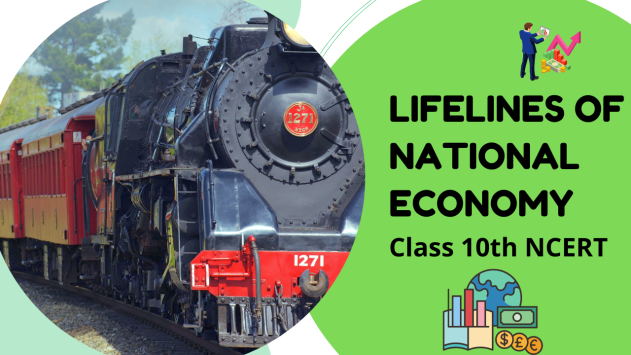We have shared Lifelines Of National Economy Class 10th NCERT notes to help the students appearing for the board examination with the lesson. We are also sharing Lifelines Of National Economy Class 10th notes along with NCERT Solutions for class 10th Lifelines Of National Economy and we have also provided Lifelines Of National Economy Class 10th Map Work to help in every possible way.
Lifelines Of National Economy Class 10th: Introduction
Lifelines Of National Economy Class 10th: Lifelines of a country
Modern means of communication and transport bring people together and help in local, national, and international trade.
Means of Transport
Means of transport that make possible the movement of goods, services, and humans/animals from one place to another place. There are different means of transport through which movement of these goods and services is done over three important domains of the earth i.e. land, water, and air.
Means of communication:-
Methods through which information, news, dialogue, etc. communicated from one place and person to another place and person are called means of communication. Such as newspapers, radio, T.V. telephone, mobile phone, e-mail, etc.
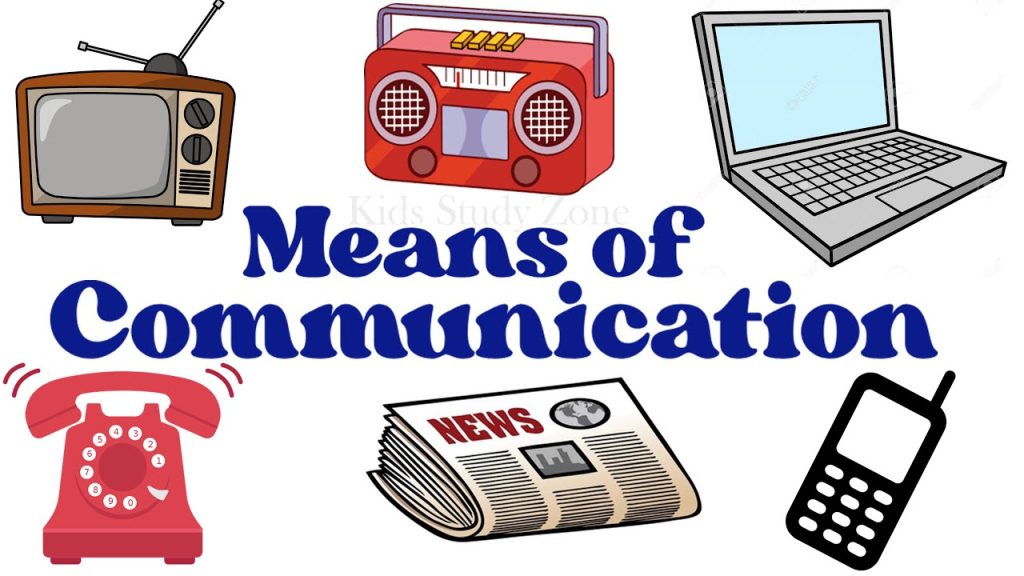
Transport
Land
Roadways
Railways
Pipelines
Water
Inland
Overseas
Air
Domestic Airways
Public Undertaking
Private Airlines
International Airways
1. Land Transport:- Land transport includes roadways, railways and
pipelines.
2. Roadways:- India has one of the largest road networks in the world which is about
56 lakh km.
Advantages of Roadways over railways-
- The construction cost of roads is much lower than that of railway lines.
- Roads can traverse comparatively in more dissected and undulating
topography. - Roads can negotiate higher gradients of slopes.
- Road transportation is economical in the transportation of few persons and
relatively smaller amounts of goods over short distances. - Provides door-to-door service, thus the cost of loading and unloading is much
lower - Feeder to other models of transport as they provide a link between the railway
stations, air and sea ports.
Classification of Roads in India
In India, roads are classified into the following six classes according to
their capacity:-
1. Golden quadrilateral:- Links Delhi, Kolkata, Mumbai, Chennai.
2. National highways:- Link extreme parts of the country.
3. State highways:- Link state capital with district headquarters.
4. District roads:- Connect district headquarters with other places of the district.
5. Other roads:- Rural roads, which link villages’ importance.
6. Border roads:- Link places of strategy more than the border in northeast and
northern border areas.
Golden Quadrilateral
- A Six lane Super Highway which connects Delhi-Kolkata-Chennai- Mumbai-
and Delhi. - The North-South corridors link Srinagar (Jammu & Kashmir) and Kanyakumari (Tamil Nadu).
- The East-West corridor connecting Silcher (Assam) and Porbander (Gujrat).
- The major objective of these Super Highways is to reduce the time and distance between the megacities of India.
- These highway projects are being implemented by the National High- way Authority of India (NHAI).
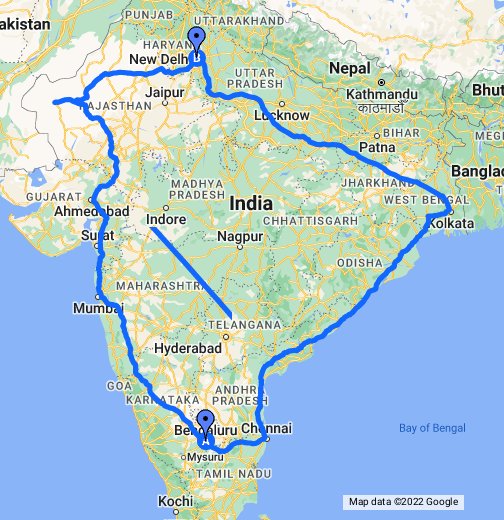
National Highways
The National highways are a network of trunk roads that are laid and
maintained by the Central Public Works Department (CPWD).
The historical Sher-Shah Suri Marg is called National Highway No.1, between
Delhi and Amritsar.
State Highways
Roads linking a state capital with different district headquarters are known
as State Highways. These roads are constructed and maintained by the State Public Works
Department (PWD).
District Roads
These roads connect the district headquarters with other places of the
district. These roads are maintained by the Zila Parishad.
Other roads
Rural roads, which link rural areas and villages with towns, are classified
under this category. These are constructed under Pradhan Mantri Grameen Sadak Yojana
(PMGSY). Under this scheme, special provisions have been made to link every village
to a major town in the country by an all-season motorable road.
Border Roads
Border Roads Organisation constructs and maintains roads in the bordering
areas of the country. This Organisation was established in 1960 for the development of roads of strategic importance in the northern and northeastern border areas.
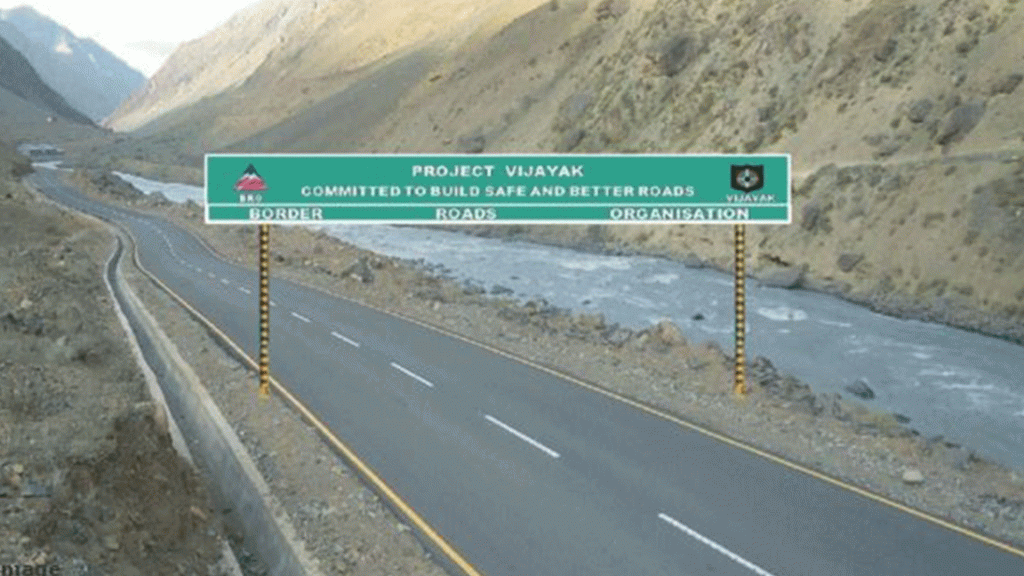
Classification of Roads on the Basis of Material Used
On this basis of type of material used, roads are of two types
Metalled Roads:- They may be made of cement, concrete, or even bitumen or coal. Therefore, these are all-weather roads.
Unmetalled or Unpaved Roads:- They are made of clay, and crushed rock and can be used in the dry season only. They have no use during the rainy season.
Major challenges of road transport:-
1. Almost half of the roads are unmetalled roads and go out of use in the rainy
season.
2. Roads are insufficient in comparison to transport and commuters.
3. Roads are narrow and crowded due to the increasing number of vehicles.
4. It leads to traffic jams and road rage.
5. Even National highways are insufficient.
Lifelines Of National Economy Class 10th: Railways
- Railways are the principal mode of transportation for freight and
passengers in India. - It also makes it possible to conduct multifarious activities like business,
sightseeing, pilgrimage along with transportation of goods over longer distances. - It has been a great integrating force along with accelerating the
development of industry and agriculture. - The Indian Railways is now reorganized into 16 zones.
- The Indian Railways network is spread over a route length of 68,442 km.
- There are 3 types of gauges (railways track) Examples:- broad gauge, meter
gauge, and narrow gauge.
Challenges for Indian Railway
It is difficult to lay railway lines in the hilly regions of peninsular India. In
these region’s railways tracts are laid through low hills, gaps, or tunnels.
The Himalayan mountainous regions too are unfavorable for the construction of railway lines due to high relief, sparse population, and lack of economic opportunities.
It requires the construction of bridges over rivers in India.
It is difficult to lay railway lines on the sandy plain of Western Rajasthan, swamps of Gujarat, and forested tracks of Madhya Pradesh, Chhattisgarh, Odisha, and Jharkhand.
There are problems with the sinking of railway tracks. For example, Sahyadri or
The Western Ghats has faced a number of problems such as the sinking of track in
some stretches and landslides.
The initial costs of laying the tracks are too high.
Some railway zones and their Headquarter:-
Northern Railway Zone – New Delhi
Western Railway zone – Mumbai
Southern Railway zone – Chennai
Challenges in Railways
It is difficult to lay railway lines in mountainous regions and it is expensive
too. The northern plains with their vast level of land provide favorable conditions
for Rail construction.
Here construction is easy and construction cost is low.
High population density and rich agricultural resources provide the most favorable condition for growth.
Due to the sparse population and lack of economic activities, it was difficult to lay railway lines on the sandy plains of western Rajasthan and in the hilly
terrains of the peninsular region.
Due to administrative reasons and Government policies also the development of Railways was affected.
Problems of Indian Railways
Many passengers travel without tickets. The theft and damage of railway property have not yet stopped completely. People stop trains by pulling the chain unnecessarily which causes heavy damage to the railway.
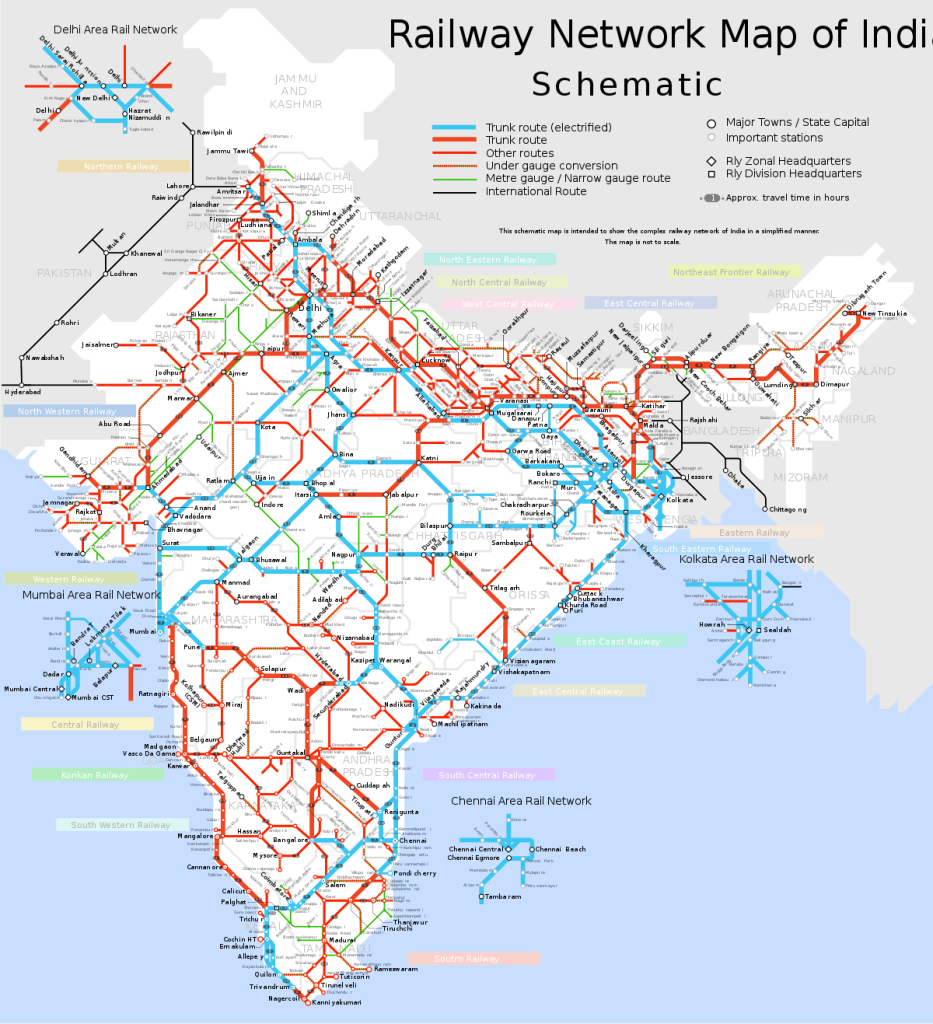
Pipelines
- The pipeline transport network is a new arrival on the transportation map
of India. - In the past, these were used to transport water to cities and industries.
- Now, these are used for transporting crude oil, petroleum products, and
natural gas from oil and fields to refineries, fertilizer factories, and big
thermal power plants. - Solids can also be transported through a pipeline when converted into
slurry.
An important network of pipeline
There are three important networks of pipeline transportation in the country. From the oil field in upper Assam to Kanpur via Guwahati, Barauni, and Allahabad. From Salaya in Gujarat to Jalandhar in Punjab via Viramgam, Mathura, Delhi, and Sonipat. Gas pipelines from Hazira in Gujarat connect Jagdishpur in Uttar Pradesh, via Vijaipur in Madhya Pradesh,
Advantages of Pipeline Transport:-
A pipeline transport network is used to transport water to cities and industries, crude oil, petroleum products, and natural gas from oil and natural gas fields to refineries, fertilizer factories, and big thermal power plants.
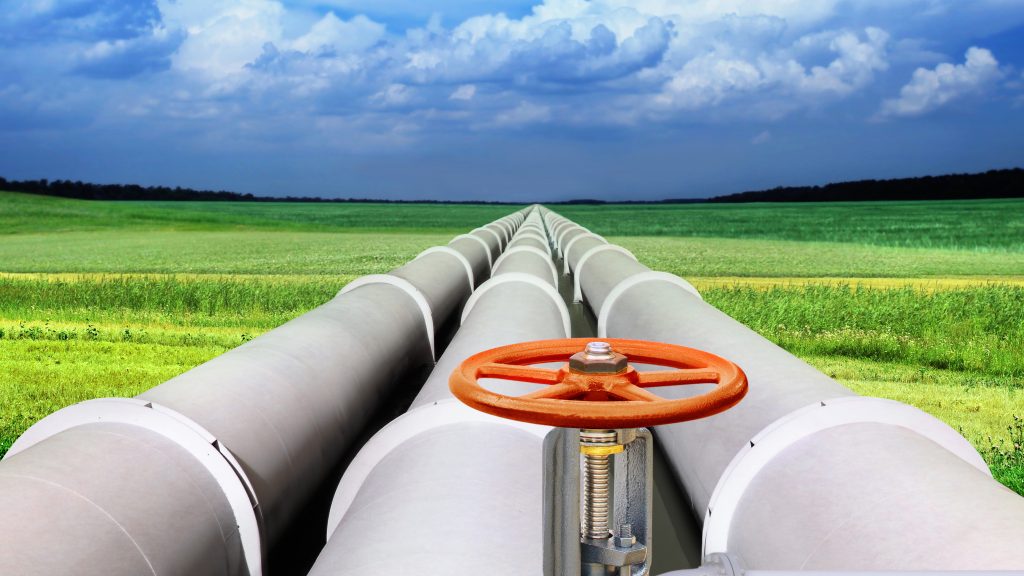
The initial cost of laying pipelines is high but subsequent running costs are
minimal.
It rules out trans-shipment losses or delays.
Pipelines make transport fast, safe, and easy.
It saves time and reduces pressure on rail transport.
Waterways
Waterways are the cheapest means of transport. It is fuel-efficient,
environment-friendly, and suitable for carrying heavy and bulky goods.
Inland Waterways:-
India has inland navigation waterways of about 14,500 km in length out
of which 5,685 km are navigable by mechanized vessels.
Waterways in India are:-
N.W. No.1:- On the Ganga river between Allahabad and Haldia (1620 km).
N.W. No.2:- On the Brahmaputra river between Sadiya and Dhubri (891
km).
N.W. No.3:- On the West-Coast Canal in Kerala (Kottappuram-Kollam,
Udyogamandal and Champakkara canals-205 km).
N.W. No.4:- Specified stretches of Godavari and Krishna rivers along with
Kakinada Puducherry stretch of canals (1078 km).
N.W. No.5:- Specified stretches of river Brahmani along with Matai river,
delta channels of Mahanadi and Brahmani rivers, and East Coast Canal (588
km).
Overseas Waterways
India’s trade with foreign countries is carried from the ports. There are
2 major and 200 notified non-majors (minor/intermediate) ports in India.
Major Sea Ports:-
With a long coastline of 7,516.6 km, India is dotted with 12 major and 200
notified non-majors (minor/intermediate) ports. These major ports handle 95 percent of India’s foreign trade.
Sea Ports in India:-
Ports on the western coast:-
Kandla Port,
Mumbai Port,
The Jawaharlal Nehru Port (Nhava Sheva) Port,
Marmagao Port,
New Mangalore Port.
Ports on the eastern coast:-
Kochi Port,
Tuticorin Port,
Chennai Port,
Visakhapatnam, Port,
Paradeep Port,
Kolkata and Haldia Port.
Airways
Air travel is the fastest, most comfortable, and most prestigious mode of
transport. It can cover very difficult terrains like high mountains, vast deserts, dense
forests, and long oceanic stretches with great ease. Air transport was nationalized in 1953.
Air India provides domestic and international air services. Pawan Hans Helicopters Limited provides helicopter services to Oil and Natural Gas Corporation (ONGC) to inaccessible areas and difficult terrains like the North-Eastern states and the interior parts of Jammu and Kashmir, Himachal Pradesh, and Uttarakhand.
Importance of Air transport:-
1. It is the fastest among all. Take lesser time to reach one place to another.
2. It is most comfortable.
3. It’s a prestigious mode of transport. can cover very difficult terrains like high mountains, dreary deserts, dense forests, and also long oceanic stretches with great ease.
4. On the border, to maintain the force and to provide them food and ration at
the earliest.
International Airports:-
An International airport offers customs and immigration facilities for
passengers traveling between countries. Delhi, Mumbai, Kolkata, Chennai, Thiruvananthapuram, Bengaluru, Amritsar, Hyderabad, Ahmedabad,
Panaji, Guwahati, and Cochin are some major international airports in
India.
Domestic Airports:-
There are 134 airports. The Government owned Airports Authority of
India (AAI) operates 122 airports and civil enclaves out of a total of 449
airports and airstrips located throughout India. Airports are managed by
the Airport Authority of India.
Communication:-
Communication is the act of conveying intended meanings from one
entity or group to another through the use of mutually understood signs
and semiotic rules.
From the earliest times, human beings have felt the need to
communicate with each other. The latest advances in communication are
about enabling communication over long distances without the need for
a change in the location of the sender or receiver.
Types of Communication:-
Personal communication:- Personal communication is where just two
or a small group of people communicate with each other. Personal letters,
e-mails, and phone calls are examples of personal communication.
Mass communication:- Mass communication is communication referred to an indefinite number of people spread over a large geographical area. Radio, television, cinema, newspapers, magazines, and the internet, are examples of communication.
Major Means of Communication in India:-
Personal communication:-
Cards and envelopes were considered first-class mail.
The second class mail includes books, packets, registered newspapers, and
periodicals.
To facilitate quick delivery of mail in large towns and cities, six mail
channels have been introduced recently.
India has one of the largest telecom networks in Asia.
Mass communication:-
Newspapers are published in about 100 languages and dialects. Along with entertainment it creates awareness among people about various national programs and policies. The Central Board of Film Certification is the authority to certify both Indian and foreign films. All India Radio (Aakashwani broadcasts a variety of programs in National, Regional and local languages.
Advantages of Mass communication
Mass communication provides entertainment.
Creates awareness among people about various National programs and
policies.
It spreads knowledge.
It broadcasts a variety of programs from entertainment and education to
sports, etc.
Doordarshan, the national television channel of India is the medium of
a national message and is one of the largest terrestrial networks in the world.
Lifelines Of National Economy Class 10th: Trade
Exchange of goods between two parties such as people, states and
countries are called Trade.
International Trade:-
Trade between two and more countries is called International trade.
95% of the country’s trade volume is moved by sea.
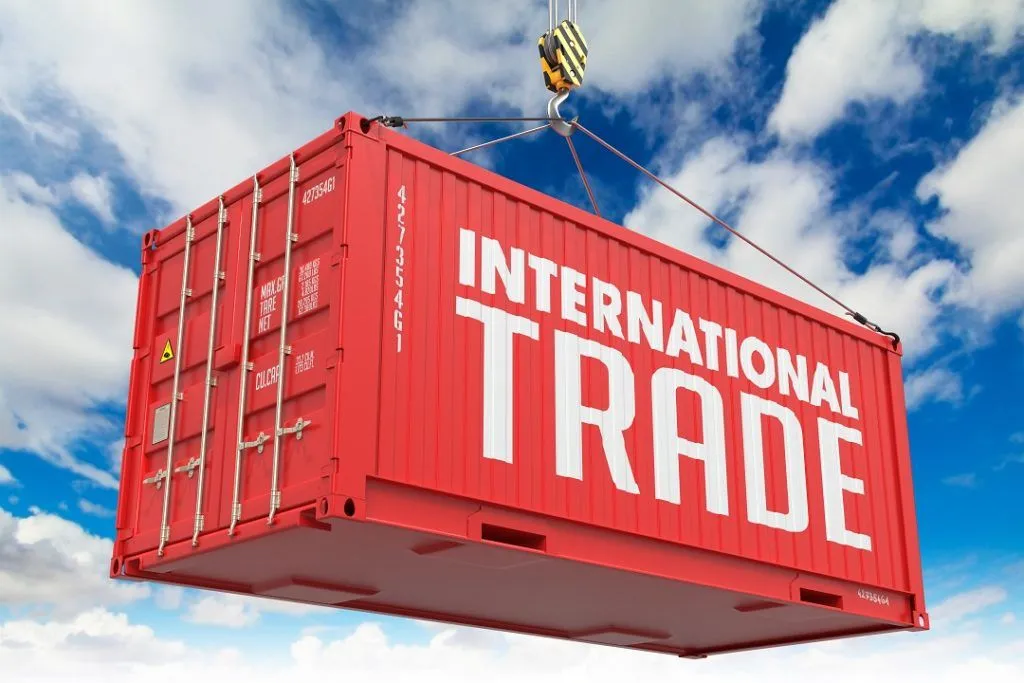
Economic Barometer
The advancement of international trade of a country is an index to its
economic prosperity. It is, therefore, considered the economic barometer
for a country.
Balance of Trade (BOT)
Export and import are the components of the trade. The balance of trade is
the difference between export and import of a country.
When the value of export exceeds the value of imports, it is called a
favorable balance of trade.
On the other hand, if the value of imports exceeds the value of exports,
it is termed an unfavorable balance of trade.
India has trade relations with all the major trading blocks and all
geographical regions of the world.
Exported and Imported Commodities:-
The commodities exported from India to other countries include gems
and jewelry, chemicals, and related products, agriculture and allied
products, etc. India has emerged as a software giant at the international level and it
is earning large foreign exchange through the export of information
technology.
The commodities imported from other countries in India include
petroleum crude and products, gems and jewelry, chemicals and related
products, base metals, electronic items, machinery, agriculture, and allied
products.
Tourism as a Trade:-
Tourism promotes national integration and develops an international
understanding. It supports local handicrafts and cultural pursuits.
New forms of Tourism:-
Heritage tourism, eco-tourism, adventure tourism, cultural tourism,
medical tourism, and business tourism. Over 2.6 million foreign tourists
visit India every year.
How is tourism helpful in the development of the economy as a
trade or industry?
Tourism in India has grown substantially over the last three decades. More than 15 million(150 lakhs)people are directly engaged in this industry. Tourism also promotes national integration. It also helps in the development of an international understanding of our culture and heritage. It also provides support to local handicrafts and cultural pursuits. It contributes significantly to earning foreign exchange.
Why are the transport and means of communication called the lifelines of an economy?
- Trade, transport, and communication are complementary to each other.
- Connects the far-reaching areas of the country and the world.
- Encourage national and international tourism.
- Brings foreign exchange.
- Life gets comfortable and easy.
- The whole country unites in an emergency.
NCERT Solutions For Class 10th Lifelines Of National Economy
Q1. State any three merits of roadways.
- The construction cost of roads is much lower than that of railway lines.
- Roads can traverse comparatively in more dissected and undulating
topography. - Roads can negotiate higher gradients of slopes.
- Road transportation is economical in the transportation of few persons and
relatively smaller amounts of goods over short distances. - Provides door-to-door service, thus the cost of loading and unloading is much
lower - Feeder to other models of transport as they provide a link between the railway
stations, air and sea ports.
Q2. Where and why is rail transport the most convenient means of transportation?
- Railways are the principal mode of transportation for freight and
passengers in India. - It also makes it possible to conduct multifarious activities like business,
sightseeing, pilgrimage along with transportation of goods over longer distances. - It has been a great integrating force along with accelerating the
development of industry and agriculture. - The Indian Railways is now reorganized into 16 zones.
- The Indian Railways network is spread over a route length of 68,442 km.
- There are 3 types of gauges (railways track) Examples:- broad gauge, meter
gauge, and narrow gauge.
Q3. What is the significance of the border roads?
- Border Roads are vital road links along the frontiers of our country.
- These roads are of strategic importance.
- These roads have improved accessibility in areas of difficult terrain mainly in the northern and northeastern border areas.
- They have played a very important role in the economic development of these areas.
- These roads are constructed and maintained by the Border Roads Organisation a government of India undertaking which was established in 1960.
Q4. What is meant by trade? What is the difference between international and local trade?
Exchange of goods between two parties such as people, states and
countries are called Trade.
International Trade:-
Trade between two and more countries is called International trade.
95% of the country’s trade volume is moved by sea.
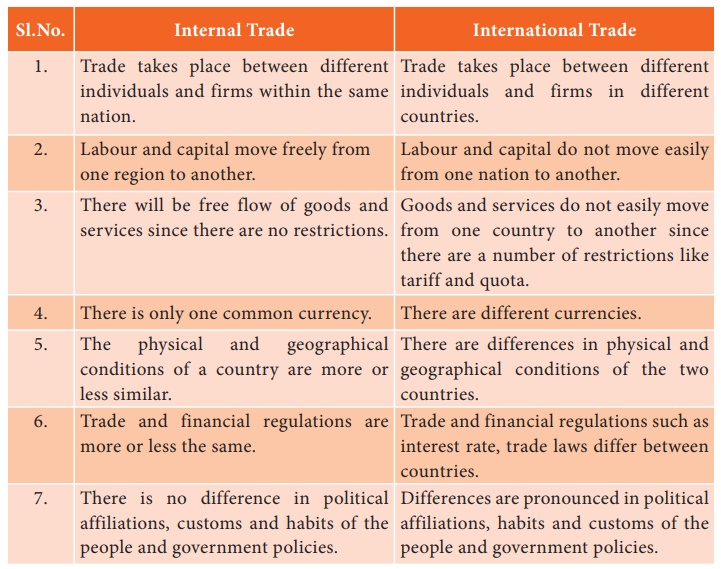
Lifelines Of National Economy Class 10th: MCQs
Question 1.
Narrow Gauge has a width of:
(а) 0.662 and 0.610
(b) 0.552 and 0.510
(c) 0.762 and 0.610
(d) 0.452 and 0.510
Answer
Answer: (c) 0.762 and 0.610
It is from 0.762 and 0.610.
Question 2.
The Indian Railway is now reorganized into:
(a) 14 zones
(b) 15 zones
(c) 16 zones
(d) 17 zones
Answer
Answer: (c) 16 zones
The Indian Railways is now reorganized into 16 zones.
Question 3.
Which of the following is a factor in influencing the distribution pattern of the Railway network in
the country.
(а) Physiography
(b) Economic
(c) Administrative
(d) All the above
Answer
Answer: (d) All the above
It has been influenced by all the above factors.
Question 4.
Solids can also be transported through a pipeline when converted into:
(а) Liquid
(b) Gas
(c) Slurry
(d) None of the above
Answer
Answer: (c) Administrative
In slurry, form solids can also be transported through a pipeline.
Question 5.
The Gas pipeline from Hazira in Gujarat connects Jagdishpur in Uttar Pradesh, via Vijaipur in:
(a) Bihar
(b) Orissa
(c) Andhra Pradesh
(d) Madhya Pradesh
Answer
Answer: (d) Madhya Pradesh
Via Vijaipur in Madhya Pradesh.
Question 6.
India has inland navigation waterways of …………………………… km in length.
(a) 14,500
(b) 15,500
(c) 16,500
(d) 17,500
Answer
Answer: (a) 14,500
It has 14,500 km in length of navigable waterways.
Question 7.
95 percent of the country’s trade volume is moved by:
(a) Air
(b) Planes
(c) Ships
(d) Sea
Answer
Answer: (d) Sea
It is moved by sea.
Question 8.
The first port was developed to ease the volume of trade on the Mumbai port:
(а) Jawaharlal Nehru Port
(b) Haldia port
(c) Mumbai port
(d) Kandla
Answer
Answer: (d) Kandla
It was Kandla port.
Question 9.
New Mangalore port in Karnataka eaters to the export of iron ore concentrates from which of
following mines:
(a) Balaghat
(b) Kudremukh
(c) Kolapur
(d) none of the above
Answer
Answer: (b) Kudremukh
From Kudremukh mines.
Question 10.
Chennai is one of the oldest …………………. ports of the country.
(a) Natural
(b) Artificial
(c) Smallest
(d) Biggest
Answer
Answer: (b) Artificial
Chennai is one of the oldest artificial ports in the country.
Question 11.
Paradip port located in Orissa specialises in the export of:
(a) Copper
(b) Bauxite
(c) Iron ore
(d) All the above
Answer
Answer: (c) Iron ore
It specializes in the export of iron ore.
Question 12.
Haldia port was developed as a subsidiary port, to relieve growing pressure on which of the
following ports:
(a) Kolkata
(b) Kandla
(c) Mumbai
(d) Tuticorin
Answer
Answer: (a) Kolkata
On the Kolkata port.
Question 13.
In which of the given years was air transport nationalized:
(a) 1943
(b) 1953
(c) 1963
(d) 1973
Answer
Answer: (b) 1953
Air Transport was nationalized in 1953.
Question 14.
The total number of telephone exchanges in India are:
(a) 37,565
(b) 36,565
(c) 35,565
(d) 34,565
Answer
Answer: (a) 37,565
There are 37,565 telephone exchanges spread all over the country.
Question 15.
When the value of imports exceeds the value of exports, it is termed as:
(a) Favourable balance of trade
(b) Unfavourable balance of trade
(c) Both (a) and (b)
(d) None of the above
Answer
Answer: (b) Unfavourable balance of trade
It is termed an unfavorable balance of trade because imports are more than exports.
Question 16.
The number of foreign tourists visiting India every year is:
(a) 2.2 million
(b) 2.4 million
(c) 2.6 million
(d) 2.8 million
Answer
Answer: (c) 2.6 million
About 2.6 million foreign tourists visit India every year.
Question 17.
Traders:
(а) Are efficient at industry making
(b) Are efficient in manufacturing goods
(c) Facilitate movement and availability of products to the consumers
(d) None of the above
Answer
Answer: (c) Facilitate movement and availability of products to the consumers
Traders are those people who facilitate the movement and availability of products to consumers.
Question 18.
Today, the world has been converted into a:
(а) Village with the help of efficient and fast transport
(b) City with the help of efficient trading
(c) Country with the help of efficient transport
(d) None of the above
Answer
Answer: (а) Village with the help of efficient and fast transport
Today the world has been converted into a village with the help of efficient and fast transport.
Question 19.
Trades from local to international levels have added to:
(a) Foreign currency
(b) Export trade
(c) Vitality of the economy
(d) None of the above
Answer
Answer: (c) Vitality of the economy
The trades from local to international levels have added to the vitality of the economy.
Question 20.
India at present has one of the largest road networks in the world, aggregating to about:
(а) 2.4 million km
(b) 2.3 million km
(c) 2.2 million km
(d) 2.1 million km
Answer
Answer: (b) 2.3 million km
It is at present 2.3 million km.
Question 21.
What is the historical Sher Shah Suri Marg called:
(a) National Highway No. 1
(b) National Highway No. 2
(c) National Highway No. 2
(d) none of the above
Answer
Answer: (a) National Highway No. 1
It is called National Highway No. 1.
Question 22.
Which is the longest National Highway:
(a) National Highway No. 1
(b) National Highway No. 5
(c) National Highway No. 6
(d) National Highway No. 7
Answer
Answer: (d) National Highway No. 7
National Highway 7 is the longest. It traverses 2,369 km between Varanasi and Kanyakumari.
Question 23.
What are roads linking a state capital with different district headquarters known as:
(a) National Highway
(b) City Highway
(c) State Highway
(d) District Highway
Answer
Answer: (c) State Highway
These are known as State Highways.
Question 24.
Who among the following maintain the district roads:
(а) Zila Parishad
(b) MCD
(c) Village Panchayat
(d) none of the above
Answer
Answer: (а) Zila Parishad
The Zila Parishad maintains the district roads.
Question 25.
On which of the following base are roads classified:
(a) Broad and narrow
(b) Long and short
(c) Type of material used for their construction
(d) None of the above
Answer
Answer: (c) Type of material used for their construction
Roads are classified on the basis of the type of material used for their construction.
Question 26.
Metalled roads may be made of:
(a) Only cement
(b) Only metals
(c) Of cement or concrete
(d) Of cement or concrete or even bitumen of coal
Answer
Answer: (d) Of cement or concrete or even bitumen of coal
Metalled roads may be made of cement or concrete or even bitumen or coal.
Question 27.
What is the length of road per sq. km of the area known as:
(a) Volume of roads
(b) Area of roads
(c) Density of roads
(d) None of the above
Answer
Answer: (c) Density of roads
It is known as the density of roads.
Question 28.
The density of all roads varies from 10 km in Jammu and Kashmir to ………………………….. km in Kerala.
(a) 365
(b) 375
(c) 385
(d) 395
Answer
Answer: (b) 375
It varies from 10 km in J&K to 375 km in Kerala.
Question 29.
In India, railways is the principal mode of transportation for:
(a) Passengers
(b) Freight
(c) Freight and passengers
(d) None of the above
Answer
Answer: (c) Freight and passengers
For both freight and passengers in India.
Question 30.
The Indian Railways have been a great integrating force for more than:
(a) 100 years
(b) 150 years
(c) 200 years
(d) 250 years
Answer
Answer: (b) 150 years
For more than 150 years.
Question 31.
The first train steamed off from Mumbai to Thane in 1853, and covered a distance of …………………………km:
(a) 30
(b) 32
(c) 34
(d) 36
Answer
Answer: (c) 34
The first train covered a distance of 34 km.
Question 32.
Broad Gauge has a width of:
(a) 1.676 m
(b) 1.576 m
(c) 1.476 m
(d) 1.376 m
Answer
Answer: (a) 1.676 m
It is 1.676 m.
Lifelines Of National Economy Class 10th: Map Work
We have shared Lifelines Of National Economy Class 10th map work to help the students with the lesson and help them understand the gist of the chapter. Map Work is very important for the students to know the points and locations on the map and be able to locate and mark the points correctly.
The National Highway Development Project is a project to upgrade, rehabilitate and widen major highways in India to a higher standard.
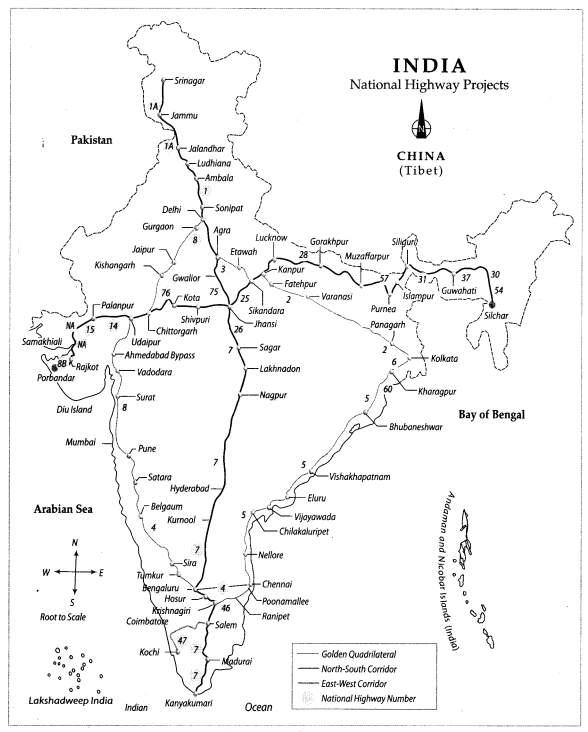
This map shows the railway network of India and its zones. Presently there are 17 railway zones.
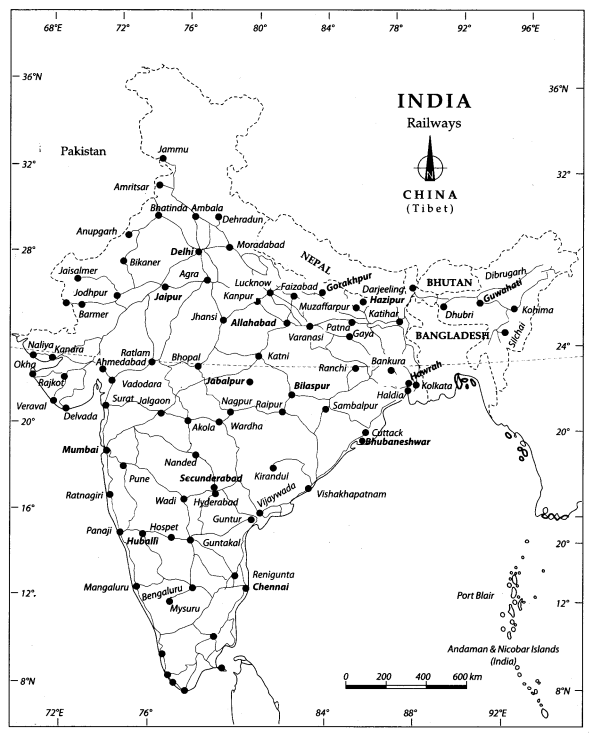
Question 1.
Features are marked by numbers in the given political map of India. Identify these features with the help of the following information and write their correct names on the lines marked on the map.
1. Southern terminal of North-South Corridor
2. The northern terminal of the North-South Corridor [CBSE 2014, 12, 11]
3. The place where North-South and East-West Corridors meet
4. The easternmost point of the East-West Corridor [CBSE 2012]
Answer
1. Kanyakumari
2. Srinagar
3. Jhansi
4. Silchar
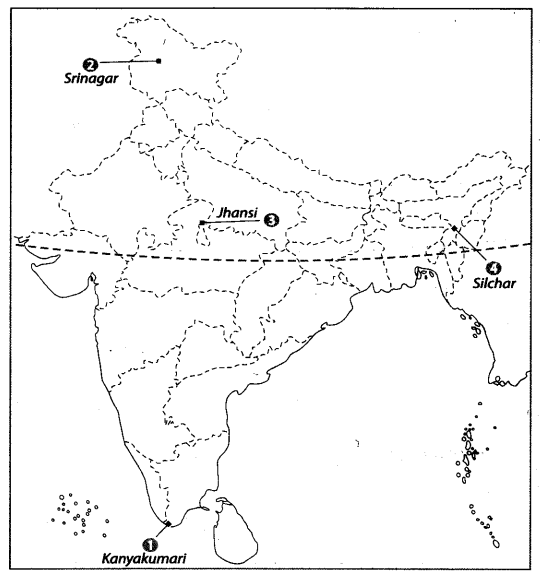
Question 2.
Locate and label the following items on the given map with appropriate symbols.
1. Porbandar
2. NH-2
3. NH-8
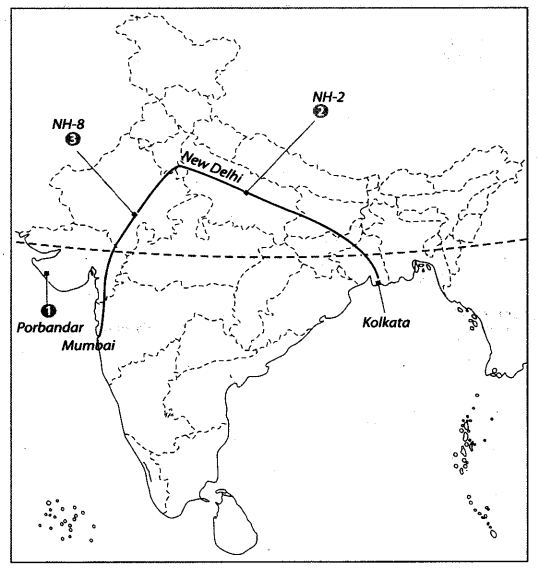
Conclusion
We provide you with Lifelines Of National Economy Class 10th NCERT notes to help the students appearing for the board examination. We are also sharing Lifelines Of National Economy Class 10th notes along with NCERT Solutions for class 10th Lifelines Of National Economy and we have also provided Lifelines Of National Economy Class 10th Map Work to help in every possible way.
Related Articles
- CBSE Class 10 Social Science Sample Question Paper 2023
- Manufacturing Industries Class 10th NCERT
- Gender, Religion, And Caste Class 10th Social Science
- Nazism And The Rise Of Hitler Class 9 Social Science
- Socialism In Europe And The Russian Revolution Class 9 Social Science
- Consumer Rights Class 10th Social Science

